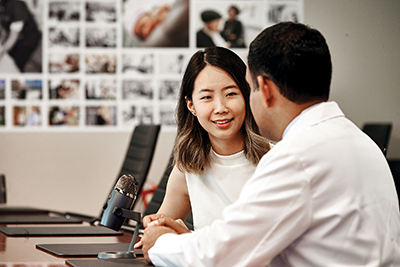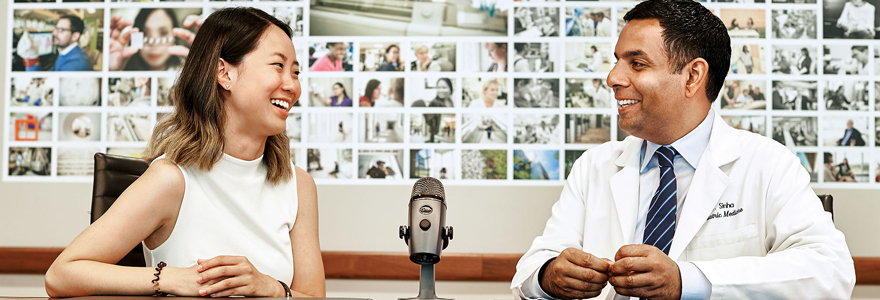Aging in the 21st Century: the Triumph and the Challenge
A conversation with Dr. Samir Sinha on rethinking senior care in Canada
Alumnus Dr. Samir Sinha, MD'02, Director of Geriatrics at Sinai Health System and the University Health Network, is transforming how Canada responds to its aging population. He serves as the expert lead for Ontario’s Seniors Strategy and was named one of Canada’s most influential people by Maclean’s magazine in 2014. He continues to be a passionate and respected advocate for older adults.
Third-year medical student and health care advocate Adrina Zhong spoke with Dr. Sinha about the current challenges and opportunities facing senior care in the country.
ADRINA ZHONG: What is the current landscape for senior care in Canada and what challenges exist?
SAMIR SINHA: When you think about caring for older Canadians, first of all, you should think about the fact that Canada is aging faster than ever before. In 1900, our life expectancy was 51 years as Canadians. Now it’s about 82. That’s something to celebrate as a huge accomplishment of public health and medical advances during the past 100 years.
And in the next 20 years, the number of Canadians who are older than 65, about five million or so right now, is going to double. Those who are 85 and older is going to quadruple, and the fastest growing age group in our country now are those people who are over 100, the centenarians.
Of course, we know that older adults tend to be greater users of health care services and they may need other supports. So this is where people start asking, well how are we going to meet the needs of an aging population?
Right now, about half of all of our public health spending is related to the care of older adults and we have to start thinking about the type of care that Canadians need as we get older. We need good access to primary care. We need access to medications that are affordable. But we also need to think about home care, nursing home care and other supports like that. And how do we weave all of this together in a comprehensive and all-encompassing system?
 AZ: I like that you view aging as such a triumph. We often don’t talk about aging on such a positive note, and maybe we should. What should be done to address the needs of an aging population?
AZ: I like that you view aging as such a triumph. We often don’t talk about aging on such a positive note, and maybe we should. What should be done to address the needs of an aging population?
SS: I think we need to ask, how are we spending our resources? What are we providing and how do we need to get the balance right? And also, how do we actually make sure we have the future health and social care workforce that we’ll need to care for an aging population?
Here you are, a medical student at Western who’s about to start her clerkship, and I think about what you’re going to be learning about in the next year or two. Western, just like many other medical schools in Canada, doesn’t mandate training in geriatrics. In your clerkship, you’re going to have a month of paediatrics, but you’re not going to have a month of geriatrics.
No matter if you become a family doctor or a general surgeon, you will actually be caring for older adults the majority of the time and you need to have the right skills. How do we make sure that you, and every other future doctor, nurse, social worker, therapist, has the right training? This is why I’m advocating that we actually mandate training in geriatrics among all of our medical schools. Because I think that it is important to put you at the forefront of the care that we’re all going to need you to provide.
The other aspect, is how do we make sure we have the right mix of care that we’re going to need in our society? We’re not providing enough care in our communities, in homes and nursing homes, so we still have a phenomenon where people are stuck in hospitals. This is that hallway medicine issue that you’re hearing about right now. If we got the balance right, then we wouldn’t have this phenomenon.
We need to get the mix of services right and we need to make sure we have the right training for our future and current health and social care providers.
“A lot of people shy away from geriatrics because caring for the elderly has always had this negative connotation. Ageism seems to be the last acceptable ‘ism’ in our society. We, as a society, don’t value older people as much as we should. And therefore we don’t tend to value the people who work with older people as much as we should.” — Dr. Samir Sinha, MD’02
AZ: In what ways do you think we can better support these solutions? As physicians, medical students, policymakers – how can we better support healthy aging and the care of older Canadians?
SS: This is not a tsunami, this is something we’ve known about since the Second World War ended and these are the demographics that will define our future. And yet, there are currently 10 times as many paediatricians in Ontario as there are geriatricians. I’m what the New York Times recently called “one of the rare, endangered species of physicians.”
I was asked to lead the creation of the Ontario government’s first-ever Senior Strategy in 2012 – to think about aging not just from a health care standpoint, but how we approach aging as an entire province. How do we think about our cities and municipalities? How do we think about wellness and prevention? How do we think about primary care, acute care, and long-term care? How do we think about caregivers? How do we think about our diverse populations and what we can do to make aging a triumph and not a liability?
We ended up with 166 recommendations and it became a blueprint for seniors-related policymaking in Ontario. By engaging physicians like myself, and hopefully yourself in the future, I have come to realize that not only is our job caring for individual patients, but we have an opportunity as physicians where we’ve got knowledge, skills, insights and that folks in government value the perspective we can bring to help shape policy. It’s really rewarding – when I can support patients on a daily basis, one-to-one, but I can also shape the future for so many older Ontarians and Canadians as well.
AZ: That’s truly the role of a physician, to be an advocate. In your work, what are the misconceptions of caring for older adults that you encounter the most?
SS: A lot of people shy away from geriatrics because caring for the elderly has always had this negative connotation. Ageism seems to be the last acceptable ‘ism’ in our society. We, as a society, don’t value older people as much as we should. And therefore we don’t tend to value the people who work with older people as much as we should. I think that’s one of the biggest barriers, that mindset.
In geriatrics, I can’t be paid for completing a comprehensive geriatric assessment, according to the government, unless I spend 90 minutes face-to-face with a patient. Patients have never spent that much time with a doctor. And for me, getting 90 minutes to put together a patient’s stories and issues – 90 years in the making – is a real privilege that allows me to get things right.
It’s fascinating, because in order to treat them today, I need to know who they are, what their experiences have been – not just their medical history, but I need to know what they’ve lived through. And you meet people who’ve lived through wars, who’ve lived through the depression, who’ve done the most interesting things.
The other thing that I love about my older patients is, frankly, by the time they’re 85 or 90, they’re not going to beat around the bush. Their goal is to stay healthy and independent for as long as possible.
 AZ: Wow, you’re really selling geriatrics!
AZ: Wow, you’re really selling geriatrics!
SS: I’ll never miss an opportunity! You’re just starting your clerkship now. You’re thinking about public health, while I’m doing public health too as a geriatrician. You have some electives in your fourth year, come join us.
AZ: It’s really fascinating, thinking about the kind of life events that lead to healthy aging and that preventative medicine piece. You also advocate for the ‘elder friendly’ approach. I’m wondering if you can shed some light on why that’s important.
SS: If you think about any hospital across the entire country, on any given day, 60 per cent of the beds are filled with older people. Yet most hospitals in Canada wouldn’t think that their biggest area of care is geriatrics.
When your patients or clients happen to be older adults, you need to start thinking about how the space is designed. When many older adults have challenges with hearing, vision, or mobility, for example, are we making sure that our places and spaces are accessible and accommodating? It’s often just simple things you can do to change the physical environment to accommodate those needs, that all of a sudden not only work well for older adults, but work well for everybody.
In my first report for the Ontario government, we also focused on this concept of age-friendly communities – the idea that if you design for the old, you design for everybody. Ontario, partly because of our Seniors Strategy, is now a world leader in this growing global movement.
So, if we adapt our health care system to meet the needs of an aging population, it can benefit all of us as well.
AZ: Thanks for sharing some great lessons. If you could leave people with one take-home message, what would it be?
SS: Aging is a triumph, it’s not a tsunami. So, think about aging as a triumph. Think about the older people in your lives and how you can make their lives easier. Because, frankly, you set an example for other people in your life to do the same for you when you get older.
* This interview has been edited for length and clarity.









